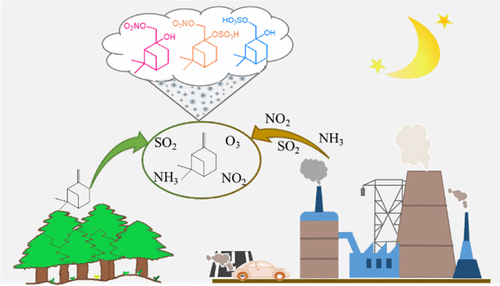当前位置:
X-MOL 学术
›
Environ. Sci. Technol.
›
论文详情
Our official English website, www.x-mol.net, welcomes your feedback! (Note: you will need to create a separate account there.)
Anthropogenic–Biogenic Interactions at Night: Enhanced Formation of Secondary Aerosols and Particulate Nitrogen- and Sulfur-Containing Organics from β-Pinene Oxidation
Environmental Science & Technology ( IF 11.4 ) Pub Date : 2021-05-27 , DOI: 10.1021/acs.est.0c07879 Li Xu 1 , Zhaomin Yang 1 , Narcisse T Tsona 1 , Xinke Wang 2 , Christian George 2, 3 , Lin Du 1
Environmental Science & Technology ( IF 11.4 ) Pub Date : 2021-05-27 , DOI: 10.1021/acs.est.0c07879 Li Xu 1 , Zhaomin Yang 1 , Narcisse T Tsona 1 , Xinke Wang 2 , Christian George 2, 3 , Lin Du 1
Affiliation

|
Mixing of anthropogenic gaseous pollutants and biogenic volatile organic compounds impacts the formation of secondary aerosols, but still in an unclear manner. The present study explores secondary aerosol formation via the interactions between β-pinene, O3, NO2, SO2, and NH3 under dark conditions. Results showed that aerosol yield can be largely enhanced by more than 330% by NO2 or SO2 but slightly enhanced by NH3 by 39% when the ratio of inorganic gases to β-pinene ranged from 0 to 1.3. Joint effects of NO2 and SO2 and SO2 and NH3 existed as aerosol yields increased with NO2 but decreased with NH3 when SO2 was kept constant. Infrared spectra showed nitrogen-containing aerosol components derived from NO2 and NH3 and sulfur-containing species derived from SO2. Several particulate organic nitrates (MW 215, 229, 231, 245), organosulfates (MW 250, 264, 280, 282, 284), and nitrooxy organosulfates (MW 295, 311, 325, 327, and 343) were identified using high-resolution orbitrap mass spectrometry in NO2 and SO2 experiments, and their formation mechanism is discussed. Most of these nitrogen- and sulfur-containing species have been reported in ambient particles. Our results suggest that the complex interactions among β-pinene, O3, NO2, SO2, and NH3 during the night might serve as a potential pathway for the formation of particulate nitrogen- and sulfur-containing organics, especially in polluted regions with both anthropogenic and biogenic influences.
中文翻译:

夜间人为-生物相互作用:β-蒎烯氧化增强二次气溶胶和含氮和硫有机物颗粒的形成
人为气态污染物和生物挥发性有机化合物的混合会影响二次气溶胶的形成,但仍不清楚。本研究探索了在黑暗条件下通过 β-蒎烯、O 3、NO 2、SO 2和 NH 3之间的相互作用形成的二次气溶胶。结果表明,当无机气体与β-蒎烯的比例为0~1.3时,NO 2或SO 2 的气溶胶产率可大大提高330%以上,而NH 3的气溶胶产率可提高39%。NO 2和SO 2以及SO 2和NH 3 的联合作用当 SO 2保持恒定时,气溶胶产量随 NO 2增加但随 NH 3减少而存在。红外光谱显示了源自 NO 2和 NH 3的含氮气溶胶成分以及源自 SO 2 的含硫物质。几种颗粒有机硝酸盐(MW 215、229、231、245)、有机硫酸盐(MW 250、264、280、282、284)和硝基有机硫酸盐(MW 295、311、325、327 和 343)被鉴定出来NO 2和 SO 2 中的分辨率轨道阱质谱实验,并讨论了它们的形成机制。大多数这些含氮和硫的物质已在环境颗粒中报告。我们的研究结果表明,夜间β-蒎烯、O 3、NO 2、SO 2和NH 3之间的复杂相互作用可能是形成颗粒状含氮和硫有机物的潜在途径,尤其是在污染地区人为和生物的影响。
更新日期:2021-06-15
中文翻译:

夜间人为-生物相互作用:β-蒎烯氧化增强二次气溶胶和含氮和硫有机物颗粒的形成
人为气态污染物和生物挥发性有机化合物的混合会影响二次气溶胶的形成,但仍不清楚。本研究探索了在黑暗条件下通过 β-蒎烯、O 3、NO 2、SO 2和 NH 3之间的相互作用形成的二次气溶胶。结果表明,当无机气体与β-蒎烯的比例为0~1.3时,NO 2或SO 2 的气溶胶产率可大大提高330%以上,而NH 3的气溶胶产率可提高39%。NO 2和SO 2以及SO 2和NH 3 的联合作用当 SO 2保持恒定时,气溶胶产量随 NO 2增加但随 NH 3减少而存在。红外光谱显示了源自 NO 2和 NH 3的含氮气溶胶成分以及源自 SO 2 的含硫物质。几种颗粒有机硝酸盐(MW 215、229、231、245)、有机硫酸盐(MW 250、264、280、282、284)和硝基有机硫酸盐(MW 295、311、325、327 和 343)被鉴定出来NO 2和 SO 2 中的分辨率轨道阱质谱实验,并讨论了它们的形成机制。大多数这些含氮和硫的物质已在环境颗粒中报告。我们的研究结果表明,夜间β-蒎烯、O 3、NO 2、SO 2和NH 3之间的复杂相互作用可能是形成颗粒状含氮和硫有机物的潜在途径,尤其是在污染地区人为和生物的影响。



























 京公网安备 11010802027423号
京公网安备 11010802027423号